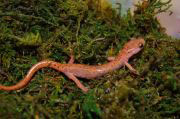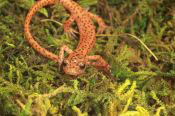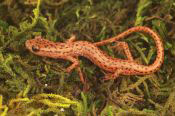Eurycea lucifuga (Rafinesque, 1822)

Key Characters: Bright orange or reddish-orange body; large eyes; black spots on sides of tail scattered rather than arranged into vertical bars.
Similar Species: Long-tailed Salamander. See Key to Adult and Larval Salamanders of Illinois for help with identification.
Subspecies: None recognized.


Description: A very long (up to 18 cm TL) salamander with a wide head and scattered black spots or blotches forming no pattern anywhere on body. Belly unspotted and pale yellowish. Mature male has a mental hedonic gland at the tip of the lower jaw and swollen cirri at the ends of nasolabial grooves. Larva slender, with low tail fin and long gill rami, darkly pigmented on anterior half of throat, and with a broad pale stripe down back. Recently transformed juvenile has shorter tail and is more yellow, closely resembling long-tailed salamanders; check differences in throat and tail pigment.
Habitat: Twilight zone of limestone caves and limestone crevices offer optimal habitat. Also found deeper within caves, and under rocks, logs, and plant debris in woodlands near caves, and around spring-fed swamps.
Natural History: Nocturnal juveniles and adults are found on damp rock walls and ledges, sometimes in large numbers. Diet includes slugs, worms, and a wide variety of insects and other arthropods. Large (5 mm diameter) pale eggs are attached to rocks in cave and underground spring pools in autumn and winter. Most hatchlings are washed out into springs and streams where they grow to transformation.
Status: Locally abundant throughout limestone regions of the Shawnee Hills and Lower Mississippi Border divisions.
Etymology: Eurycea – possibly a mythological reference to Eurydice, wife of Orpheus; longicauda – lucifuga – lucifugus (Latin) for light-shunning.
Original Description: Rafinesque, C.S. 1822. On two new salamanders of Kentucky. Kentucky Gazettee, Lexington, N.S. 1(9):3.
Type Specimen: Not designated.
Type Locality: “near Lexington . . . . in caves and in the dark; but not in water”
Original Name: Eurycea lucifuga Rafinesque,1822
Nomenclatural History: E. lucigifuga was transferred to Splerpes and later reduced to a subspecies of E. longicauda by Mittleman (1942, Proc. New England Zool. Club, 21: 105). Bishop (1943, Handb. Salamanders:431) elevated it back to species status. Other names used in the Illinois literature include Splerpes maculicaudus (Cope, 1890), Am. Nat., 24: 967.


